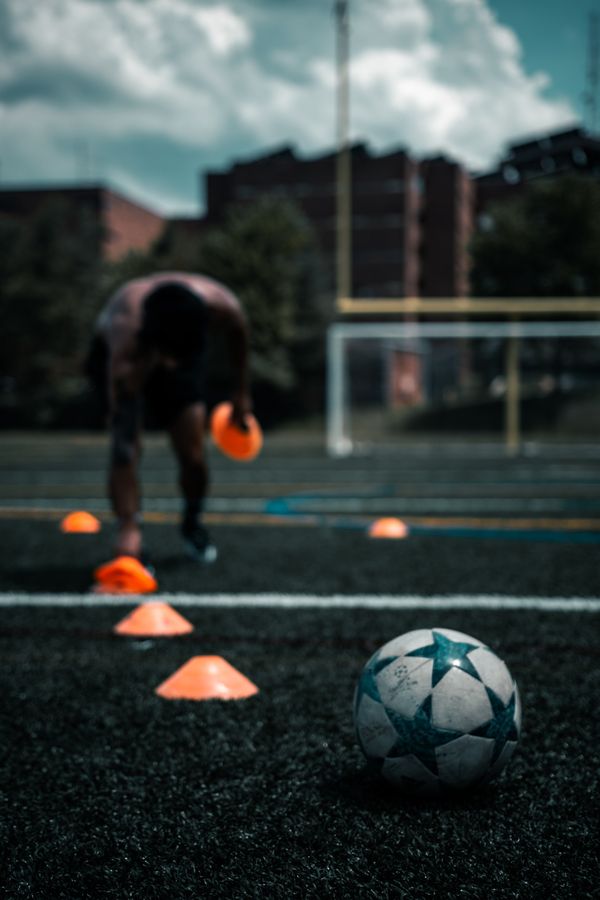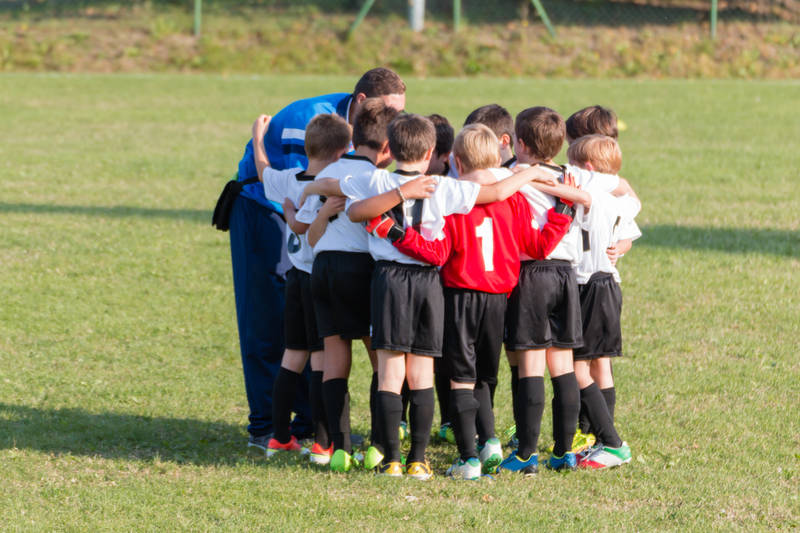Whether you're a youth club manager or a semi-professional football coach, having the right training equipment can make all the difference in player development. Football coaching equipment encompasses a wide range of tools designed to enhance various skills, from passing accuracy to goalkeeping reflexes. High-quality training gear allows coaches to create effective practice sessions that target specific skills while keeping players engaged and motivated throughout the season.
The market offers equipment suitable for every skill level, from beginners just learning the fundamentals to advanced players refining their techniques. Basic items like cones, bibs, and pop-up goals form the foundation of any coach's kit, while specialised equipment such as rebounders, agility ladders, and resistance parachutes can elevate training sessions. Many grassroots coaches across the UK have transformed their training methods by investing in versatile equipment that serves multiple purposes.
Modern football coaching has evolved beyond traditional drills, with innovative training aids now available that weren't accessible to previous generations of coaches. Portable passing arcs, precision targets, and electronic timing gates have become increasingly popular at all levels of the sport. While American soccer coaches might focus on different aspects of training, UK football coaches typically prioritise equipment that enhances ball control, tactical awareness, and game-specific scenarios relevant to the European style of play.
Essential Training Equipment
Building a strong football squad requires strategic planning and the right tools to develop skills effectively. Quality training equipment helps coaches create structured sessions that enhance player technique, agility and tactical understanding.
Cones and Hurdles for Agility Drills
Cones are perhaps the most versatile and cost-effective training tools available to football coaches. Their simple design allows for countless drill configurations to improve footwork, change of direction and spatial awareness.
When setting up agility circuits, use different coloured cones to designate various movements or stations. Mini-cones work well for close-control dribbling exercises, while taller marker cones provide better visibility for distance drills.
Hurdles complement cones perfectly by adding a vertical dimension to training. Available in adjustable heights, they develop explosive power in players' legs through controlled jumping movements.
Popular agility equipment combinations:
- Mini-cone slalom courses (10-20 cones)
- Ladder and hurdle speed circuits
- Reaction drills with coloured cones
Tackling Skills with Blocking Sleds
Defensive training requires specialised equipment that allows players to practise tackling technique safely. Blocking sleds provide resistance while teaching proper body positioning and controlled defensive movements.
Single-player sleds help develop individual tackling mechanics, while multi-station versions allow several defenders to work simultaneously. Look for sleds with padded surfaces and sturdy construction to ensure safety during intensive sessions.
For younger players, softer pop-up mannequins offer a gentler introduction to defensive positioning without the intimidation factor of larger equipment.
The best blocking equipment combines mobility with stability. Wheels make repositioning easy between drills, while proper anchoring prevents unwanted movement during contact exercises.
Developing Precision with Throwing Aids
For goalkeepers and outfield players alike, throwing accuracy represents a crucial skill in modern football. Training aids like rebound nets and target walls significantly improve passing precision and ball control.
Adjustable rebound boards offer variable angles to practise different types of passes. These versatile tools can challenge players to control bouncing balls or execute one-touch passes with increasing difficulty.
Wall targets with designated zones help goalkeepers enhance distribution accuracy. Portable options allow for quick setup anywhere on the training ground.
Essential throwing development equipment:
- Rebounder nets with tension adjustment
- Portable goal targets with precision zones
- Ball-return systems for solo practice
Many professional academies now use specialized soccer throwing equipment that tracks accuracy metrics, providing valuable feedback for players developing their distribution skills.
Advanced Football Training Aids
Professional football training has evolved significantly with specialized equipment designed to enhance player development and strategic understanding. Modern coaching aids help players refine their technical skills, improve set-piece execution, and develop tactical awareness through deliberate practice.
Rebounders for Ball Control
Rebounders have become essential tools for enhancing first touch, passing accuracy and overall ball control. These versatile devices feature angled surfaces that return the ball at varying speeds and trajectories, simulating game-like scenarios. Players can practise independently, focusing on receiving techniques with both feet.
The most advanced rebounders offer adjustable angles and tension settings to create different challenges. Some models include target zones to improve precision in passing drills. Multi-sided rebounders allow for group training exercises where players can work on quick one-touch passes.
For goalkeepers, specialised rebounders help develop reaction saves and handling skills. These training aids are particularly valuable during the winter months when outdoor training conditions may be less than ideal.
Free Kick Mannequins for Set Pieces
Free kick mannequins have revolutionised set-piece training in football. These durable, lightweight figures create realistic defensive walls, allowing players to practise curling shots around obstacles just as they would in match situations.
Modern mannequins come in adjustable heights, typically ranging from 150cm to 195cm, to simulate different-sized opponents. The best models feature weighted bases for stability in windy conditions, while remaining easy to reposition during training sessions.
Coaches often arrange these mannequins in various formations to create specific training scenarios. They can be used to practise attacking free kicks, defensive wall positioning, and corner kick routines.
Many professional clubs now use inflatable versions that reduce injury risk whilst maintaining realistic dimensions. These training aids have become increasingly popular at grassroots level, where coaches previously relied on cones or teammates to simulate defensive walls.
Coaching Boards for Tactical Awareness
Tactical coaching boards remain one of the most effective tools for developing players' positional awareness and strategic understanding. Traditional magnetic boards feature movable pieces representing players, allowing coaches to illustrate formations, positioning and movement patterns.
Digital alternatives have gained popularity, with soccer-specific apps offering animated play sequences and the ability to record and share tactical plans. These digital solutions often include libraries of pre-set formations and common game situations.
The most effective coaching boards include:
- Dual-sided designs (full pitch/half pitch views)
- Colour-coded markers for clear team differentiation
- Erasable surfaces for quick adjustments
- Portable folding designs for matchday use
Many coaches use these boards during pre-match team talks and half-time discussions. They provide visual reinforcement that helps players understand positional responsibilities and tactical adjustments more clearly than verbal instructions alone.
Football Equipment for Youth Coaching
Selecting the right training gear is essential for developing young footballers effectively. Quality equipment tailored to children's needs ensures safe practice while building fundamental skills.
Age-Appropriate Training Gear
Youth football coaching requires specialised equipment that considers the physical development of young players. For the youngest age groups (5-8 years), smaller, lightweight footballs (size 3) are crucial as they allow proper technique development without overwhelming small hands and feet.
Training bibs in bright colours help organise teams during practice and enhance visibility. These should be lightweight and breathable for comfort. Smaller goals and portable nets are perfect for youth training sessions, allowing coaches to create various practice stations.
Essential Youth Training Gear:
- Size-appropriate footballs (size 3 for U8s, size 4 for U9-U12s)
- Mini goals and portable nets
- Lightweight, breathable bibs in different colours
- Low, flexible marker cones for drills
- Adjustable hurdles for agility training
Safety equipment like shin guards must be properly sized for children rather than using adult versions cut down.
Skill Development with Youth Drills
Effective youth coaching equipment should facilitate skill development through engaging drills. Flat disc cones are excellent for marking dribbling routes and creating boundary lines without posing trip hazards.
Agility ladders help develop footwork and coordination—essential skills for young footballers. These should be supplemented with small hurdles (15-30cm high) to practise jumping and movement patterns.
Blocking shields and tackle dummies designed specifically for youth players allow safe practice of fundamental techniques. Unlike their American soccer counterparts, these are smaller and lighter for appropriate development.
Popular Skill Development Equipment:
- Agility rings for footwork drills
- Ball rebounders for passing practice
- Portable free-kick mannequins (youth-sized)
- Speed chutes for resistance training
- Skill training markers
Training equipment should grow with players, gradually increasing in challenge as they develop. Quality youth training gear, while sometimes costly, represents an investment in player development and safety.
Organising and Storing Your Football Equipment
Proper storage and organization of football equipment extends its lifespan and ensures everything is ready when needed for training sessions and matches. Effective storage solutions help maintain equipment quality while making inventory management more efficient.
The Importance of Ball Bags
Ball bags are essential for any football coach managing equipment. These specialized carriers allow for easy transportation of multiple footballs between storage areas and training grounds. Many modern ball bags can hold between 10-15 balls, with premium options featuring compartments for additional training items.
Quality ball bags should be made from durable, water-resistant materials to protect contents from weather conditions common in the UK. Look for reinforced stitching and sturdy zippers that can withstand regular use.
When selecting ball bags, consider those with shoulder straps or wheels for easier transportation. Some coaches prefer mesh designs that allow air circulation, helping wet balls dry naturally and preventing mildew development.
Proper labelling of ball bags can help differentiate between match balls and training balls, streamlining preparation for different sessions.
Maintaining Your Training Aids
Training aids require thoughtful storage solutions to preserve their functionality and extend their usable life. Cones, markers, bibs, and agility ladders should be cleaned regularly before being stored in dry, ventilated areas.
For bibs and fabric items, washing after each use prevents odour buildup and maintains hygiene standards. These items should be completely dry before storage to prevent mould growth. Consider investing in specialised storage racks or bins that separate clean bibs by colour or size.
Hard plastic equipment like cones and hurdles should be rinsed to remove mud before storage. Many professional and amateur football clubs use mobile storage systems with customised shelving that accommodates various equipment shapes and sizes.
Create a systematic inventory process to track equipment condition. This helps identify when items need replacement before they become unusable or potentially dangerous during training exercises.
Show less











